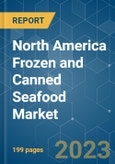The North America Frozen and Canned Seafood Market is projected to register a CAGR of 1.12%
Key Highlights
- Largest Segment by Country - United States: Close to 75% of the consumption is in the US. Frozen seafood is very popular in the age group between 18 and 37 years, primarily ready-to-eat and ready-to-cook products.
- Largest Segment by Type - Fish: The introduction of processed fish products in the ready-to-eat and ready-to-cook category will boost demand, with consumers leaning towards value-added products.
- Fastest-growing Segment by Country - Mexico: Mexico is one of the biggest seafood producers with sustainable practices in the region, with a preference for frozen and canned seafood with low fat and high protein.
- Fastest-growing Segment by Type - Shrimp: Frozen shrimp is seen as a non-perishable product in North America. Hence, more importers, distributors, and foodservice operators in North America prefer to use it.
Key Market Trends
Fish is the largest segment by Type.
- The frozen/canned fish segment accounted for the major share of the market, with an increase of 5.98% by value in 2021 as compared to the previous year. The primary factors influencing the North American market for frozen seafood products are the rising demand for convenience meals, such as ready-to-eat (RTE) and ready-to-cook (RTC) goods, and the increasing health-consciousness among consumers.
- The frozen/canned seafood market grew by 38.75% by value from 2016 to 2021. Due to busy lifestyles, growing urbanization, and high disposable incomes, the demand for easy-to-prepare and easy-to-consume food is also increasing.
- The global demand for high-quality, sustainably-sourced fish and seafood is growing at an incredible rate. Frozen/canned fish consumption accounts for more than 36% of the overall seafood consumption in North America. Seafood is perishable and must be treated carefully from the time it is removed from the water. Thus, supermarkets and hypermarkets offer super-fast freezing techniques that help keep frozen/canned seafood fresh for a long time.
- The other seafood segment, including lobsters, crabs, and oysters, is expected to be the fastest-growing segment in Mexico, with a CAGR value of 5.82% during the forecast period (2022-2028). There is growing awareness of the advantages of seafood on health, thus attracting more consumer attention toward the category. The sales of frozen and canned lobsters, crabs, and oysters observed a hike of 22.70% during 2019-2020 in Mexico. The increasing adoption of Western culture is also boosting the consumption of lobsters and crabs.
United States is the largest segment by Country.
- The United States dominates the North American region, with almost 3/4th of the frozen and canned seafood consumed compared to other countries like Canada and Mexico in 2022. Most people in the age group of 18 years to 37 years prefer consuming frozen and canned seafood to fresh seafood. The United States had a higher population of 62% and 87% more than Mexico and Canada, respectively, in 2021, which resulted in an increased market share of frozen/canned seafood in the United States.
- COVID-19 helped increase the sales of frozen and canned seafood across North America in 2020 and 2021. The added advantage of long shelf life and year-round availability across various market channels with increased consumer health awareness fueled frozen seafood sales volume and value. Nearly 73% of US households purchase frozen seafood compared to fresh seafood.
- Mexico is anticipated to be the fastest-growing country in the consumption of frozen and canned seafood, and it is projected to register a CAGR of 2.41% by value during the forecast period (2022-2028). Mexico is one of the largest seafood producers, and it provides more than 40% of domestic seafood using sustainable practices. Almost 39% of the Mexican population has high BMI rates, attracting consumers toward frozen and canned seafood with low fat and high amounts of proteins and nutrients.
- The pandemic disrupted the supply chain, leading to a decrease in the availability of frozen seafood by 5.6% due to the closure of manufacturing units. This disruption resulted in an increase in frozen seafood prices for instance the price of fish increased by 5.47% from 2016-2021, which was comparatively lower than red meat.
Competitive Landscape
The North America Frozen and Canned Seafood Market is fragmented, with the top five companies occupying 17.78%. The major players in this market are High Liner Foods Inc., Mowi ASA, Sysco Corporation, Thai Union Group PCL and Trident Seafood Corporation (sorted alphabetically).Additional Benefits:
- The market estimate (ME) sheet in Excel format
- 3 months of analyst support
Table of Contents
1 INTRODUCTION
4 MARKET INSIGHTS AND DYNAMICS
5 MARKET SEGMENTATION
6 COMPETITIVE LANDSCAPE
Companies Mentioned (Partial List)
A selection of companies mentioned in this report includes, but is not limited to:
- Admiralty Island Fisheries Inc.
- American Tuna Inc.
- Beaver Street Fisheries
- Bolton Group Srl
- Dongwon Industries Ltd
- Dulcich Inc.
- FCF Co., Ltd.
- Gulf Shrimp Co. LLC
- High Liner Foods Inc.
- Mowi ASA
- Pacific American Fish Company Inc.
- Sysco Corporation
- Thai Union Group PCL
- Trident Seafood Corporation
Methodology

LOADING...










